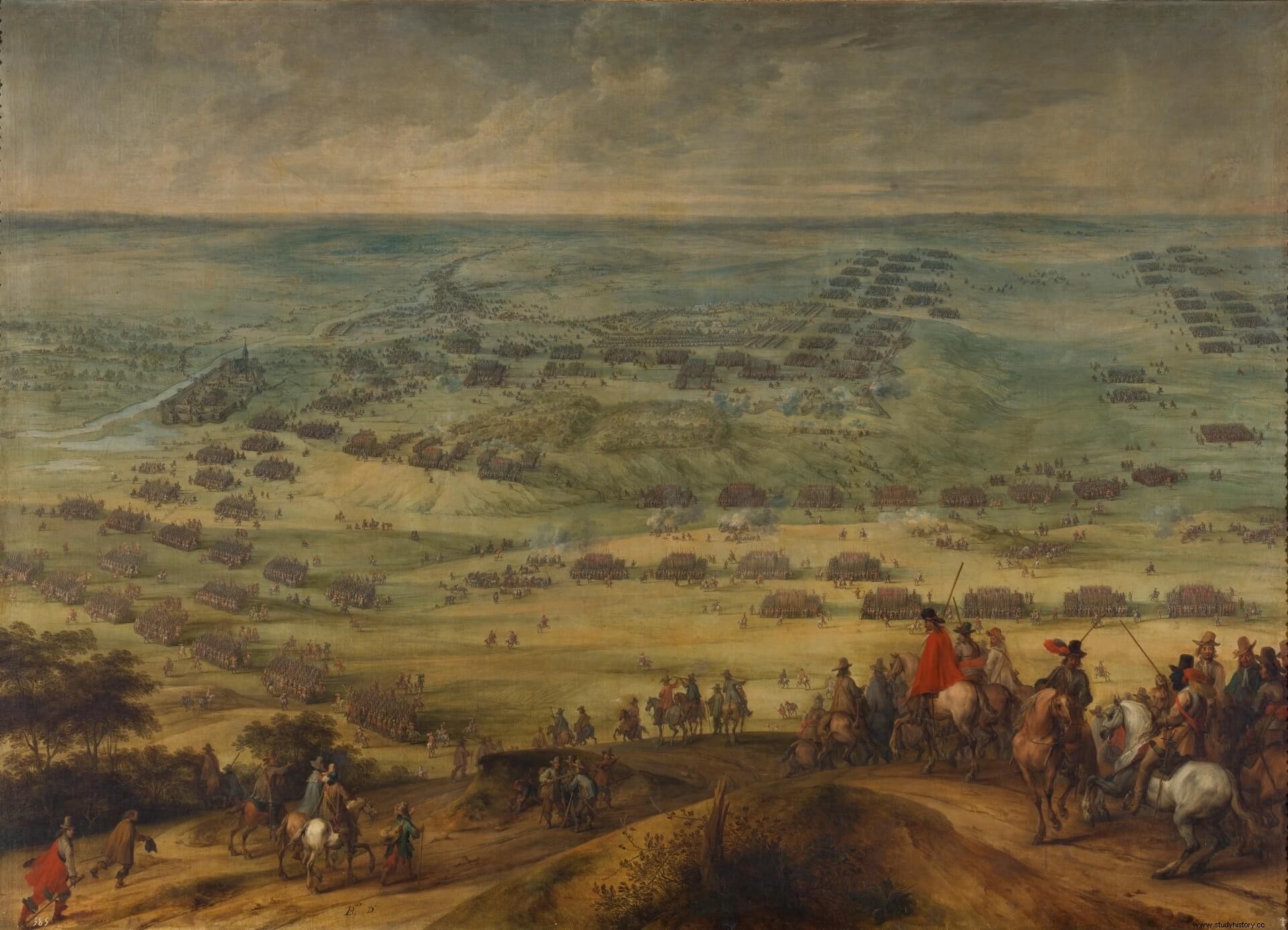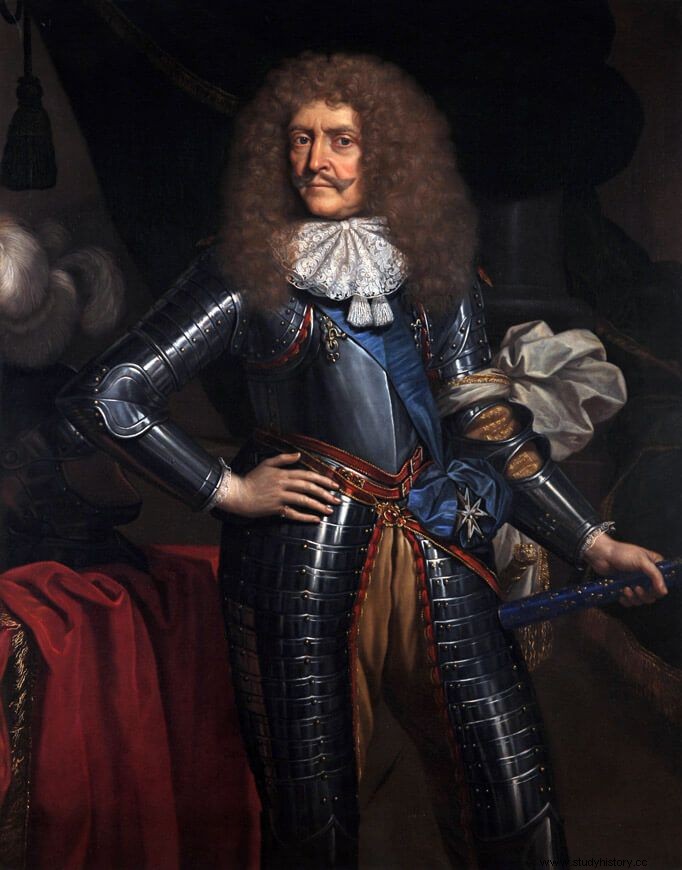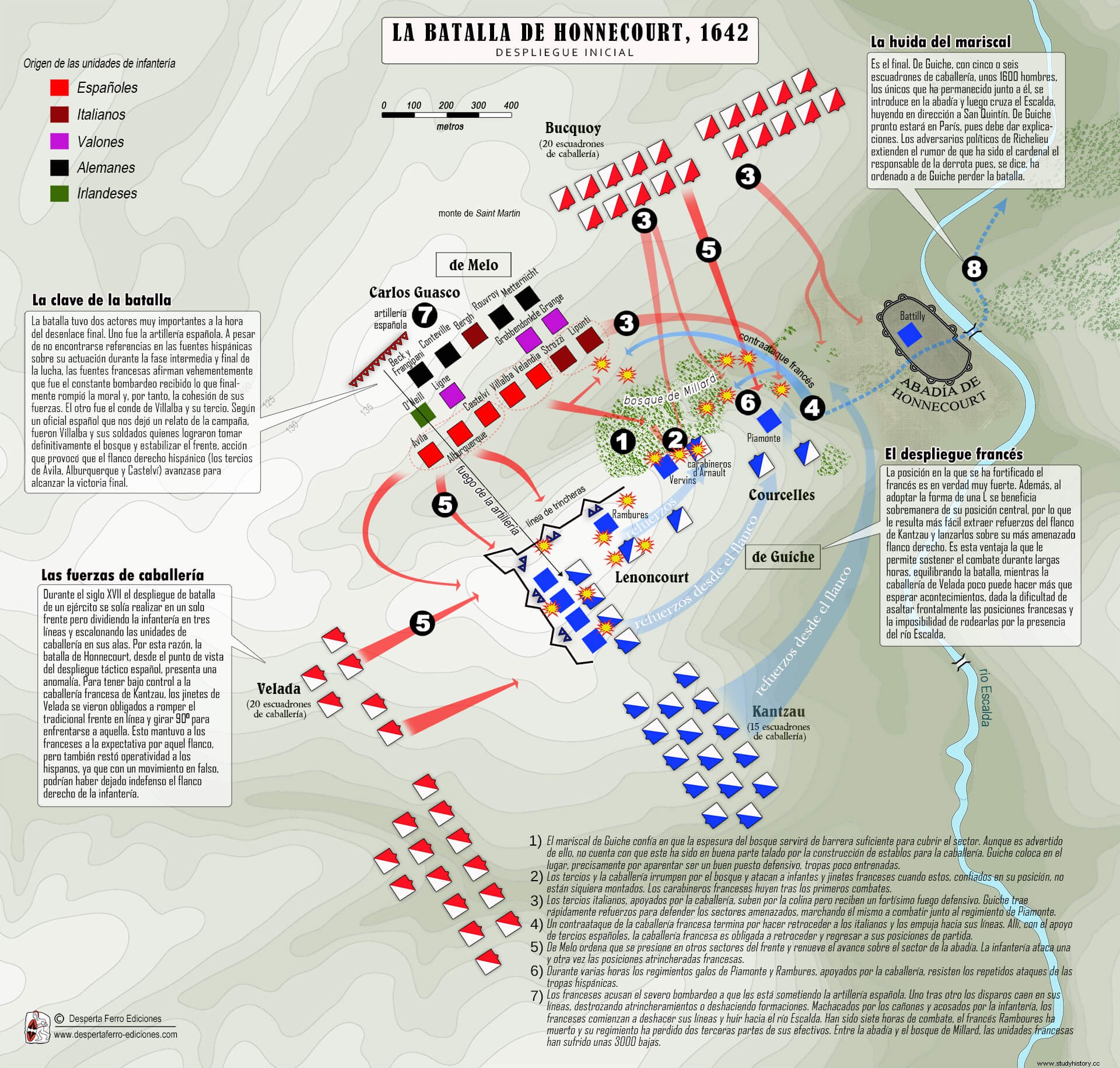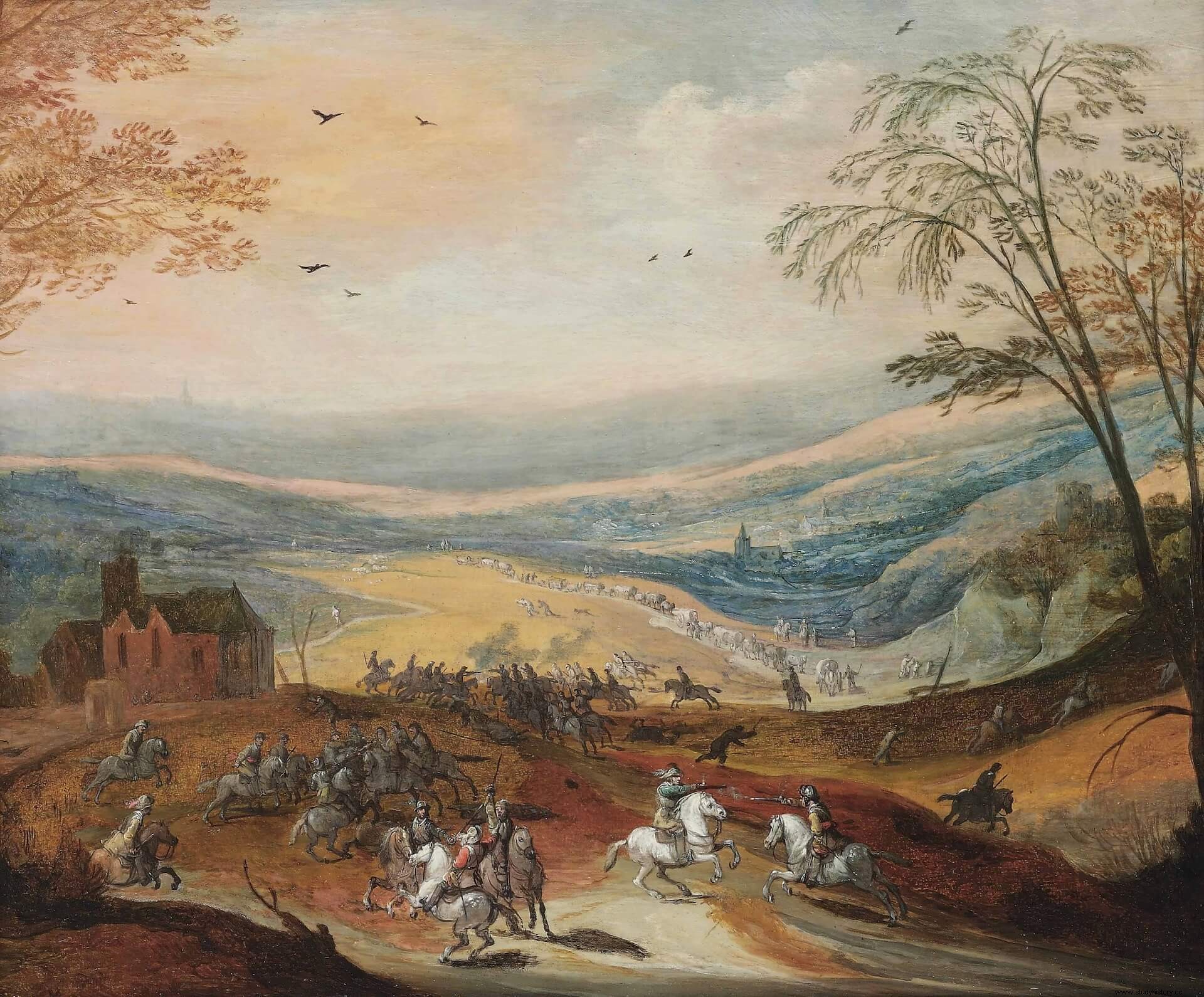
In 1635 France declared war on the Hispanic Monarchy , so Philip IV and his favorite, the count-duke of Olivares , they were forced to stand up to Louis XIII and his favourite, Richelieu , to maintain Spanish hegemony in Europe.
The formal French declaration was made melodramatically in Brussels, making it clear that the Catholic Netherlands was going to be the French priority objective, although other military fronts were later opened where the armies of both crowns:Italy, the Basque Provinces, Roussillon and Cerdanya. With the entry of France into the war, Hispanic Flanders was surrounded by the enemy both to the south and to the north of its borders, since from the year 1621 the Monarchy was once again at war with the Dutch Republic. Consequently the Army of Flanders was forced to divide into at least two corps to face the French and Dutch armies at the same time. This fact has not been given due relevance despite the importance it had, as will be seen later.
Therefore, Flanders suffered the blow of two different annual campaigns that put the economic and military resources of the Monarchy to the limit. Having to deal with two enemies at the same time, the fate of the Spanish weapons was mixed. After several years of conflict, the strategy followed on the southern front was clearly outlined:both contenders laid siege to the border towns with the intention of taking them to maintain control over the enemy territory and exploit it through contributions, take the war to the enemy population and free their own from the horror of war.
From the beginning of hostilities, the Catholic Netherlands was led by Cardinal Infante, don Fernando , brother of Felipe IV, who had shown himself to be an excellent soldier, despite having been raised as a man of the Church:under his command the victories of Nördlingen and Kalloo (1638) had been achieved. However, he died on November 9, 1641 in Brussels. From that moment on, the governorship in the interim regime fell to the Portuguese Francisco de Melo, Count of Asumar, man of the Count Duke of Olivares and who had courtly, diplomatic, governmental and military experience (he was present at the battle of Tornavento, 1636 ). After having been ambassador to Genoa, Lucca, Florence and the Holy Roman Empire and Viceroy of Sicily, he was requested by Brussels to serve the Cardinal Infante.
The beginning of the governorship of De Melo it was all a success. The square of Aire-sur-la-Lys returned to Spanish hands after a siege that lasted from September 8 to December 7, 1641. During the eviction operations, Cardinal Infante caught the fever that ended his life . Still, de Melo was able to finish the siege happily. After the victory, the troops were quartered in the middle of January. The most striking thing about this operation was that it took place during the fall and winter, seasons in which the armies of the Modern Age did not usually camp.
The campaign begins
The Hispanic intelligence services reported that the French effort that year was going to be directed fundamentally against Roussillon and Cerdanya, and it seemed that Louis XIII himself was going to take the lead of his troops. Madrid informed De Melo, who decided to go on campaign as soon as possible to try to divert as many French troops as possible from the Spanish front.
After preparing the defenses and garrisons of all the border squares, the entire Army of Flanders began to assemble, since the spies had reported that that year the Dutch would take to go camping. With great secrecy De Melo prepared the offensive. His first objective was the reconquest of La Bassée , located so far inside the territories of Felipe IV that it prevented the Army of Flanders from launching a direct attack against France, as well as demanding contributions from Lille and its region, and part of the province of Flanders. However, before taking that town, Lens had to be recovered to isolate the objective and prevent a relief army from surprising the Hispanic troops. Andrea Cantelmo commanded the troops that besieged Lens, which only took two days to retake it after unleashing two attacks so ferocious that on April 19 the doors of the population were opened.
With their rear guard covered, the main body of the army moved against La Bassée, which was defended by about 3,000 Frenchmen. The siege was especially hard and complicated both because of the excellent defense carried out by the garrison and because of the attempt to break the siege carried out by a French relief army. After recognizing the defense device put in place by De Melo, the French troops, commanded by the count of Harcourt and Marshal de Guiche , they withdrew without deciding to engage in combat. Finally, when everything was ready for the walls of the town to be blown up by mines and then a general attack would be launched against it, the governor of the square decided to surrender it if they were not helped by another relief army in two days. On May 13, the square was evicted by the French, after having lost some 600 men in eighteen days of siege.

After the end of the siege, part of the troops de Melo had to move to the northern border, as the Dutch began to prepare their army for their annual campaign. The Governor General of Flanders, for his part, maneuvered with the intention of dividing the French relief army, which, having withdrawn, was increasing its strength. The feint was successful:the troops under the command of Harcourt headed for Hesdin while those led by Guiche headed for Le Châtelet. Thanks again to the excellent Spanish intelligence services, De Melo was continually on the lookout for enemy movements. Calling on the Baron de Beck and the Earl of Bucquoy to join him with his troops, Imperial reinforcements were received under the command of the Baron de Enckevort.
The strategy pursued by the Governor General was very simple:place his army between the two French corps with the intention of preventing them from meeting again. After a council of war, the Hispanic high command decided to advance on Guiche to challenge him to battle, despite the fact that his camp was in French territory and very well fortified. During the march the Spanish army was divided into three corps, vanguard, battle and rearguard, arranged in such a way by Beck, who served as general field master during the march, which took place on May 26.
The Battle of Honnecourt
The sudden Spanish advance caught the French army completely off guard:some 7,000 infantry and 3,000 cavalry with ten artillery pieces. The infantry was composed of the regiments of Rambures, Piémont, Marquis de Persan, Marquis de Saint-Mégrin, Vervins and it is believed that those of Huxelles, Beausse, Quincy, the English of Hill and the Irish of Bellings and FitzWilliam . The total was divided into eight squads, while the cavalry had been divided into twenty-one, with an "L" shaped deployment, with four infantry squads per side and their outer flanks covered by cavalry. The camp was situated on a hill and had been heavily fortified on two of the four flanks, while the third was covered by Honnecourt Abbey and a forest; the fourth was sheltered by the river Scheldt. The Gallic scouts did not detect the enemy until they were two leagues away, and furthermore, at first, they believed that it was only Beck's troops making a raid.
The first troops that arrived before the French were 2,000 horsemen supported by 1,000 musketeers, all under the command of Baltasar Mercader, who, to learn of the Gallic deployment, began to skirmish. Meanwhile, Beck began to prepare the Hispanic army, placing the artillery, under the command of Carlos Guasco, on a hill that commanded the enemy positions. Due to the greater height and the enfilade disposition, the twenty Spanish guns bombarded the French field with great effectiveness.
The Hispanic infantry, some 14,000 men, divided into three lines, stood at a level below the artillery. In the first, from right to left, were the Spanish thirds Alonso de Ávila, the Duke of Alburquerque, Jorge de Castelví, the Count of Villalba and Antonio Velandia, followed by the Italian thirds of Count Strozzi and Giovanni de Liponti. The Spaniards, as was customary at the time of squadrons, covered the right flank, the most exposed to enemy attacks and, therefore, the one with the greatest risk. The Italians, for their part, covered the right, in theory not as exposed but in the same row as the Spanish. The precedence at the time of marching and fighting was a point of honor between these two "nations", which more than once came to be settled by the edge of the swords. No officer, Spanish or Italian, ever accepted that his unit was delayed to a less exposed place. Honor and glory were everything for a military man.
In the second row stood, again from right to left, the third of Irish of Owen Roe O’Neill and the Wallon thirds of the Prince de Ligne, the Baron de Grobbendonk and monsieur of the Grange. It should be noted that Beck placed on the right flank, as has already been said the most dangerous, the Irish and not the Walloons. The Irish "nation" enjoyed at that time a well-deserved reputation for daring men and faithful followers of the Monarchy, so they were treated almost as if they were Spanish despite not being vassals of Philip IV. His field maester, Owen Roe O'Neill, had for years been regarded by the Cardinal Infante as one of the most competent officers serving in the Army of Flanders, and had therefore always refused to reform his unit, despite the orders from Madrid in this regard.
In the third row stood, from right to left, a German squadron made up of the Beck and Frangipani regiments, Monsieur de Conteville's Walloon third, and the German regiments of Bergh, Rouvroy and Metternicht.
As was customary at the time, the flanks of the infantry were guarded by the cavalry, some 5,000 strong. The right flank, formed by twenty Spanish, Italian and German units, was commanded by the Marquis de Velada. The left, made up of twenty other cavalry units from the country, Alsace and Luxembourg, was under Bucquoy.

Beck ordered the Villalba and Velandia Tercios, supported by the entire second rank, to advance, so they went down the hill and stood in the valley formed between the two rises, just opposite one of the flanks guarded by fortifications. To his left, Bucquoy launched himself into the gap between the abbey and the forest, supported by the Italian two-thirds. The entire left body went into motion.
Once Villalba and Velandia's units reached the valley, they began to climb the enemy hill through the forest, which was guarded by a large number of French soldiers. To neutralize them, the Spanish field marshals ordered four sleeves of musketry to come forward and unleash their full firepower, forcing the enemy to retreat after a single charge. Meanwhile, Bucquoy's cavalry attacked the French, located next to the abbey, with the support of Strozzi's musketry. The attack was a complete success:the French horsemen retreated, overwhelming two of their own infantry regiments. Bucquoy and his men managed to enter the enemy camp while the musketry sleeves of Villalba and Velandia managed to join them after having crossed the forest. The soldiers took up positions ready to withstand the enemy counterattack, which was swift due to the freedom of action that the inactivity of the Hispanic right corps had given them.
The Bucquoy Riders they resisted the onslaught of the Gallic cavalry as best they could. Liponti's Tercio endured a large number of casualties as they were unable to take a defensive disposition as the onslaught caught them with their ranks open. After seeing the Italian musket sleeves destroyed, Guasco led the unit and tried with his reformed captains and officers to hold off the enemy at pike point, but they had to retreat.
Meanwhile, Beck, who had been watching the attack unfold from close range, was forced to take refuge within the Velandia Tercio, who, after crossing the forest, had halted his advance and formed a defensive squad after seeing Bucquoy's forces repulsed. For its part, the Villalba unit had carried out the same operation. Both, once motionless, began to fire continuously on the counterattacking French units, thus making it easier for the soldiers of Liponti, Strozzi and Bucquoy to regroup after reaching the valley between the two hills. The Spanish fire had made the French desist from their counterattack and returned to their camp.
For the second time the Hispanic left corps charged back uphill through the gap between the abbey and the forest. However, it was pushed back again due to the reinforcements that the French units in that sector had received. However, this time the second line, made up of the Irish and the Walloons, joined the attack after climbing the slope and sustaining three charges from the enemy cavalry once they reached the top of the rise. This action allowed Bucquoy's cavalry and Liponti's and Strozzi's infantry to advance for the third time, definitively breaking the enemy's resistance.
De Melo, after being informed of the result of the last charge, finally ordered the right corps to advance against the enemy. The Tercios of Alburquerque, De Ávila and Castelví launched the attack, supported by Velada's cavalry and Mercader's troops. The Hispanic horsemen collided with the French while some units were guarding the flank of the infantry, which positioned itself in front of five Gallic squads that were protected by their trenches. Three times the Spanish infantry climbed the hill and three times they were repulsed. However, on the fourth attempt, the Tercios managed to storm the trenches and enter the enemy camp, despite being somewhat disorganized. Velada's and Mercader's horsemen joined them after making it to a more distant place.
Despite the Spanish partial successes, the French did not surrender, forcing De Melo to advance to the third rank, commanded by Enckevort. This traveled the same path that the Spanish units had climbed. As De Melo personally joined the attack, it gained in intensity. The Spanish infantrymen, spurred on by the presence of the Governor General, launched themselves against the enemies bare-chested and managed to circumvent the trenches, make the enemy infantry retreat and seize the artillery. Velada, on his part, broke the enemy cavalry. When everything seemed to indicate the victory of the Army of Flanders, the French horsemen, drawing strength from weakness, returned to counterattack. But Velada and his men, supported by a group of cavalry that until then had escorted De Melo, finally disrupted the Gallic horsemen.
After the partial victories, first by the left corps and then by the right, the laurels of triumph were in the possession of the Spanish army. The French infantrymen, after losing their artillery and seeing their cavalry totally destroyed, began a disorganized retreat that ended up turning into a breakout. Guiche barely escaped while many survivors of his army drowned trying to cross a bridge over the Scheldt after being attacked by Mercader's musketeers. Others managed to reach Le Châtelet, where they took refuge. Even so, many succumbed to the swords of the Spanish, German and Croatian cavalry, which were launched in pursuit of the fleeing. Meanwhile, the German soldiers of Enckevort together with some cavalry units looted the enemy baggage.

It was estimated that the French casualties they had risen to about 4,000, while almost 3,000 men were arrested. Guiche lost all his flags and banners, including the famous Cornet Blanche , which had never fallen to enemy power after 200 years of fighting. The loot in general was very rich:about 500 tanks, all the artillery... The Hispanic infantry had been as decisive as expected; even the cavalry in this battle had managed to not only match the French, but even surpass her.
That night de Melo's army slept on the same battlefield, making sure that the remnants of Guiche's units did not join Harcourt's army, which was advancing on marches forced into the area, to return to battle. Since this did not happen, the Hispanic soldiers were able to rest for three days.
Despite what has been written about de Melo's lack of activity after the victory, without any basis, it must be said, he was unable to exploit his success . His attention had to be directed to the Rhine frontier, since a mercenary army in the pay of France was operating in the Archbishopric of Cologne, and to the northern frontier, where the Dutch had begun to mobilize their troops. In addition, Harcourt continued to maneuver along the southern border. For all these reasons, the Army of Flanders had to be divided into three corps, which made it impossible to launch an offensive against the heart of France.
Conclusion
If the Spanish-French War (1635-1659) had ended in 1642, after the Battle of Honnecourt, it would be said that De Melo was an excellent Governor General, that the Army of Flanders had been the instrument of victory and that Beck could be considered one of the best general field masters in his history.
The Hispanic deployment for battle – the infantry arranged in three lines and in checkerboard with the flanks protected by the cavalry (which in turn was supported by musketry) while the artillery covered their advance – indicates that the high command of the army was perfectly aware of the latest innovations in the art of war and put them into practice. In addition, the firepower was fundamental in the victory, without forgetting that the pikes also had their role when it came to assaulting the enemy fortifications. The development of the battle shows constant communication between the various members of the high command and great flexibility when it comes to operating:the first line divides in two to attack both to the right and to the left.
All of the above indicates that the Army of Flanders' conception of war was by no means obsolete. The overwhelming victory it was due to the size of the army, almost double that of the French, but also to the determination of the troops when storming the enemy fortified camp. The Tercios were still elite units and as such they complied.
The following year the same troops that had been victorious were defeated, curiously by an army that was also larger than the Hispanic one. But the Army of Flanders did not perish in Rocroi, since the usual pair of army corps had returned to operation, so not all the troops were found before the French city and casualties were not as high as some Gallic historians have claimed. stubborn in writing, and Spanish historians in copying without contrasting them. Despite the setback –which some have come to call “the tomb of the Tercios ”– in February 1644 the Army of Flanders numbered 12,992 officers and 64,745 soldiers; 77,737 troops in total, of which 5,935 were Spanish infantrymen. During the rest of the 17th century, Flanders continued to be the parade ground par excellence of the Tercios until the decree of their extinction, signed by Felipe V de Borbón.
Bibliography
- Albi de la Cuesta, July (2017):From Pavia to Rocroi. The Spanish Tercios . Madrid:Awake Ferro Editions.
- Cánovas del Castillo, Antonio (1888):Studies on the Reign of Felipe IV , 2 vols., Madrid.
- “Letters from some fathers of the Society of Jesus on the events of the Monarchy between the years of 1634 and 1648, volume IV”, in Spanish Historical Memorial , vol. XVI, Madrid, 1862.
- González Palencia, Ángel (1944):New biographical news of D. Francisco de Melo, winner of Le Chatelet (1597-1651) , Madrid.
- Hrnčiřík, Pavel (2005):“The battle of Honnecourt in 1642 by Peeter Snayers in the Prado”, Bulletin of the Prado Museum , no. 41.
- Parrott, David (2001):Richelieu’s Army. War, Government and Society in France, 1624-1642 , Oxford.
- Vincart, Jean-Antoine (1873):“Relationship of the Flanders campaign of 1642”, in Collection of unpublished documents for the history of Spain , vol. 59, Madrid.
- Wilson, Peter H. (2018):The Thirty Years War. A European tragedy. 2 volumes, Madrid:Wake Up Ferro Editions.
